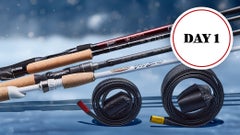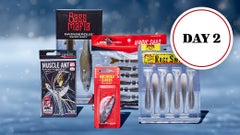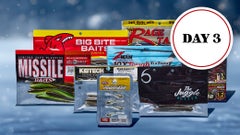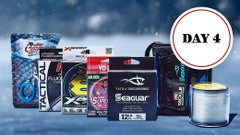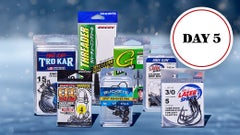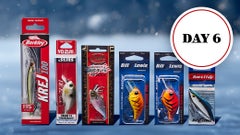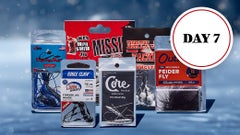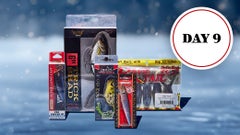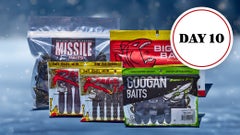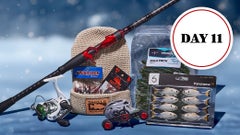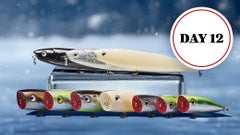Ray Hanselman Wins Lake Amistad Rayovac
Hanselman called his practice session "extensive" as he knew the fish were likely to only be in certain areas, especially the ones that had moved up into pre-spawn locales. "Having this much local knowledge and time, it can hinder you because you're checking too many spots or finding fish all over the place," he said. "With the fishing tough, there weren't a bunch of fish everywhere. I always do better when the fishing's tough É I can just go catch one here and two there. It just worked. "I don't want to sound arrogant, but you just have that advantage of having a few more places to go look. I knew if I had a chance to win at home, this was going to be it." He figured 75 to 80 percent of the bass are still holding in deep water on the main lake canyons, but he was able to locate a few drains that had healthy grass on the bottom to supplement his ledge pattern and honey hole up the river. He had a few days of 12 to 13 pounds with one 18-pound day in practice so he felt like he had a good handle on what to expect come tournament time. "They don't know that certain areas have started to set up," he said of the fish that have yet to rise into pre-spawn mode. "Coming out of practice, I felt like I'd make the cut. If everything worked halfway decent, I thought 11 a day would make the cut and I felt like I could do that without a big one. If I caught a big one, that'd be icing on the cake."
Competition:
Hanselman keyed on subtle, grassy drains leading into a flat on day 1. The area he'd found was 15 to 18 feet deep with 4 to 5 feet worth of vegetation off the bottom. His first offering was a Wahoo Wing Ding Tail Spinner that he'd first let sink to the bottom before ripping out of the grass. The Wing Ding resembles the Mann's Little George, but the Wing Ding allows for line-through rigging straight to the hook. "It's a small, compact bait and you just throw it out and let it sink to the grass and then rip it up and out," Hanselman said. "A lot of people don't throw it because it looks cheesy. You can't always throw it here because when the water gets up, we get a lot of timber in the water and it can get hung pretty easily. With the water where it's at now, it's perfect. You can cover a lot of water with it and get a school fired up." He'd follow up with a deep-diving crankbait and an umbrella rig slow rolled above the grass. He caught several keepers on the Wing Ding and wound up weighing two on day 1. He added a 4 1/2-pounder on the umbrella rig from the same spot. He then made a long run up the river to an area where a warm spring comes into the lake. He threw a 5-inch swimbait there and caught five keepers and finished out his limit there. He opted for the 5-inch size "because I was just trying to get bites," he said. "I didn't want to push my luck." He moved back down the lake to a main-lake ledge not far from the dam that came up from 40 feet to 20 on top. He'd marked fish there in practice, but wasn't sure if they were largemouth or smallmouth. He came off plane well off the waypoint and turned his transducers off to help his stealthiness. He made one long pitch with a dropshot and let it go to the bottom. When he picked up his rod tip, he felt some weight and brought in a 3 1/2-pound smallie that gave him a 2-pound upgrade and left him with a little more than 15 1/2 pounds on day 1. "We weighed in more than 100 smallmouth this week," he said. "It's always had them, but now we're starting to catch 3- and 4-pounders."
He opted to start on the smallmouth on day 2 since he wasn't sure if there was a school of them still there - he'd marked maybe 15 to 20 in practice. It turned out to be a mistake as the area was right in the middle of the lake and other tournaments boats were whizzing by, stirring up the water and ultimately turning the fish off. He caught one dink smallie there and on another nearby spot before deciding to head to his warm spring area up the river. "We'd had a cloudy, warm night Thursday so I figured some more probably moved in there," he said. "I knew I could catch a limit there. I just didn't know how big they'd be." He caught a 2 3/4-pounder right away, then a 6-pounder on the swimbait. He then saw another good one follow his bait back to the boat, but not commit. He repositioned his boat in relation to the sun and shadows and gave the fish 15 to 20 minutes to head back to the boulder he swam out from. A few casts later, Hanselman caught it - a 5 1/2-pounder. "I caught one other 3 1/2 on the swimbait, then flipped couple stretches of hardwood that was in there as well," he said. "I wound up with seven keepers up there, three on the swimbait and four flipping." His 19-06 stringer catapulted him into the lead after day 2, setting the stage for a nerve-wracking final day on his home water. "My stomach was in knots," he said. "I'd rather have to come from behind. I've led at Rayburn before and I was dying inside thinking it would happen again." He started the final day on the deep grass he'd fished on day 1. "I wanted to catch some fish to calm me down and it worked out," he said. "I caught two keepers right away and a few short fish." He moved to another grassy drain that he didn't fish on day 1 and added almost a 3-pounder there. By then it was 9:30 and he felt like he needed to head north to his stretch in the river.
"It was slow at first and I missed one flipping," he said. "I started to go into a little panic mode. I'd run out of the Rage Craws so I put on a Zoom Speed Craw and pitched it up off the back side of a boulder and I saw my line start to move. It was close to a 6-pounder." He stayed there until 1 p.m. and had four fish in the boat before running back to the spot he started on. He missed a bite on the Wing Ding with his first cast, but cleaned up with a Norman DD-22 on the next throw and caught a 3. On the way back to the ramp, he threw the Wing Ding at another clump of grass in 28 feet of water and caught another 3 that helped him cull a 14-incher. "I knew I wasn probably no worse than third," he said. "The chances of someone catching a 25-pound bag and catching up were slim, but I knew Denny or Brian could catch 17 or 18 and catch me. They were on big fish, just not enough."
Winning Pattern:
Hanselman says Amistad had a good year of hydrilla growth last year and that will bode well for the fish to return to the medium-range depths again. "It's going to take a cycle of them to spawn up there and stay," he said. He could tell the fish he was catching had recently moved up just by looking at them. "These fish were almost pale white, like they were just out in the ocean," he added. "You could tell they had been in deep water and had recently moved up." Regarding the warm spring area he fished, he said it's one of many springs that flow into the lake. The one he fished, in particular, was putting 70-degree water into the lake. "That area was 60 to 65 degrees, which is prime spawning temperatures," he said. "They were ready."
Winning Gear:
Wing Ding gear: 7' medium-heavy Power Tackle Paragon Series casting rod, Shimano Citica casting reel (6.5:1 gear ratio), 20-pound Seaguar InvizX fluorocarbon line, 3/4-oz. Wahoo Lures Wing Ding Tail Spinner (Tennessee shad holographic).
Swimbait gear: 8' medium-heavy Power Tackle Ultimate Swimbait Special casting rod, Shimano Curado casting reel, 17-pound Seaguar InvizX fluorocarbon line, 5" Top Shelf Magnum Jr. Deep Runner line-through swimbait (special trout), #2 unnamed treble hook. He's a big fan of the Top Shelf swimbait because "it'll run true no matter how fast you reel it. It runs straight as an arrow," he said. "I've been fishing swimbaits a long because it's by far the most consistent producer down here. That's my favorite one."
Flipping gear: 7'6" medium-heavy Power Tackle Paragon Series casting rod, same reel as swimbait, 65-pound Sufix 832 Advanced Superline, 3/8-oz. Strike King tungsten flipping weight, 7/0 Gamakatsu octopus hook, Strike King Rage Tail Craw and Strike King Rodent (Okeechobee craw) He favors an octopus hook for flipping because it won't flex on hooksets like other flipping hooks do. "It's basically a tarpon hook," he said of the 7/0 Gamakatsu model he uses. "Whenever I'm flipping, it's all I use."
Main factor: "I'd like to say it was ability, but I know it was having the knowledge from being here my whole life - 20 years of guiding plus the 20 years before that. Without the deal up the river, I think I would've make the cut, but maybe not have won."
Performance edge: "That Skeeter/Yamaha combo I have. I ran the dog crap out of it every day, 6,000 RPM for an hour up and an hour back. It got me there every day and I wasn't worried about it. I know it's good equipment. That's why I'm in it. Also, the Power Tackle rods, the Shimano reels, the Power-Poles to catch that one big fish - it's the best equipment and you have to have it all. Even the smallest things are so important in a tournament situation."
Lake Amistad Winning Pattern Bassfan 2/17/15 (Todd Ceisner)








